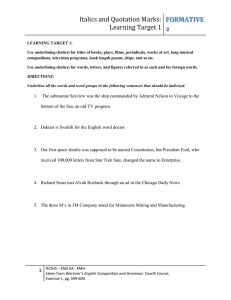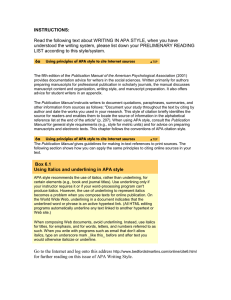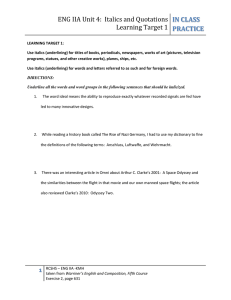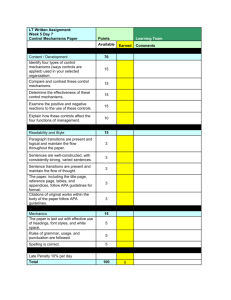Experimental Psychology
advertisement
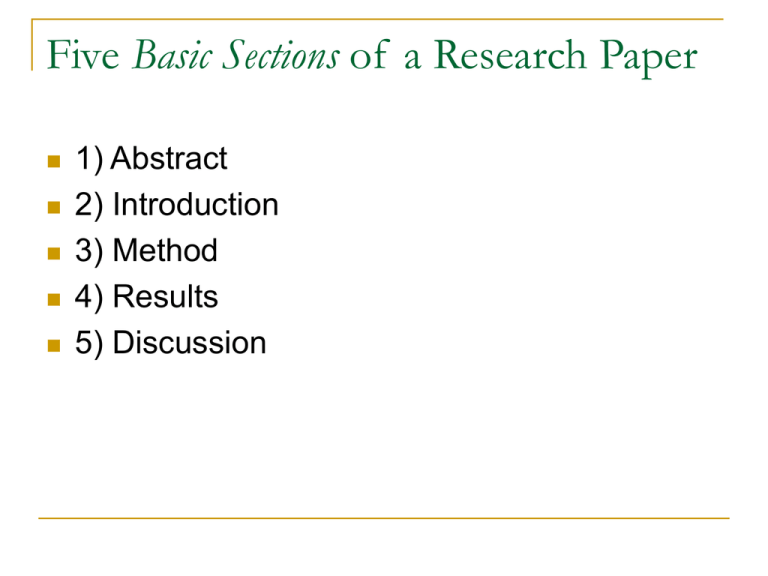
Five Basic Sections of a Research Paper 1) Abstract 2) Introduction 3) Method 4) Results 5) Discussion Order of APA Paper Sections The order of the sections of the manuscript are as follows: A.Title Page B.Abstract C.Introduction D.Method E.Results F.Discussion G.References H.Other Sections Appendix Tables Figure captions Figures Title Page The title page formally announces the title and running head of your lab report. The title page contains: The article title Author name(s) Author affiliation Manuscript page header Page number Running head Abstract The abstract is the "Reader's Digest" version of the paper Condensed format. Abstracts must be condensed yet stand alone. The abstract should be understandable to someone who has not read the paper. Order. Its purpose is to show the reader the research at a glance. Each section of the paper requires 1 to 2 sentence in the abstract. Information is arranged in the same order as the sections in the lab report: Introduction, Method, Results, and Discussion. Single paragraph. Abstracts should be presented as one paragraph. Introduction The goal of the introduction is to justify your study. Introduce the research question Summarize the research done to date Not just the studies whose results you agree with. Identify studies that support an opposite finding, and explain what might underlie the differences. Explain what work has yet to be done (your study). At the end, state your hypotheses. Method The Method section is a detailed breakdown of your experiment. Give the reader enough information to be able replicate the experiment. The Method section is often divided into subsections (for example: ) Participants and Design Materials Procedure Measures Note: Current APA style requires ITALICS where you see underlining here. Results This section presents the statistical analysis of the data collected. The Results section is the most condensed and standardized of all the sections in a paper Statistical results are presented but not discussed in this section. States what stat procedures were used and the results of the analyses As predicted, children who viewed the aggressive model were significantly more aggressive than children in the no-model condition t (18) = 4.03, p < .01. The mean aggression score in the model group was M = 5.20 and in the no-model group was M = 3.10. Discuss results in the Discussion section. Note: Current APA style requires ITALICS where you see underlining here. Note: Current APA style requires ITALICS where you see underlining here. Discussion In this section, interpret your results by relating them to your hypotheses. Discuss the results in relation to each hypothesis. Discuss possible explanations for your results. Use words to explain the quantitative information from the results section. Do the results agree or disagree with the ideas that you introduced in the Introduction? How do the results relate to previous literature or current theory? Identify and discuss limitations of the study. Generalize your results. References Must contain complete citations for all sources mentioned in the paper Use APA format Capitalization, spacing, punctuation, and underlining must be exactly as specified. Appendix, Tables and Figures Appendix Tables and figures often represent results more clearly and concisely than does text. Tables Put information that would be distracting in the body of the paper (like questionnaires or a list of stimulus items) Often statistical information (correlations, means, etc) are placed in a table. Figures AKA Graphs A separate page with Figure Captions is provided before the figures Note: Current APA style requires ITALICS where you see underlining here. The Hourglass Method INTRODUCTION METHOD Very narrow, detailed, technical, and specific. RESULTS Starts out very broad, ends up narrowly focusing on your specific study and its hypotheses Still narrowly focused on the specific results of the specific tests you performed to test your hypotheses. DISCUSSION Starts out very narrow, summarizing your results; then becomes broader as you discuss the implications and limitations to your research; ends up broadly conveying the 2-4 most important things you want your readers to remember from your research.
